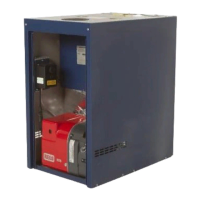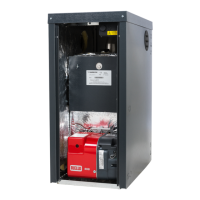Page 72
10.2.5 Low Pressure Switch
Where there is a catastrophic loss of water from the system the boiler thermostats may fail to
operate which would result in serious damage to the appliance. To prevent this it is
recommended that a low pressure cut out switch set at 0.2 bar is fitted to the system and wired
in series with the boiler limit thermostat.
10.3 Combi Domestic Hot Water
10.3.1 Mains Water Pressure
To protect the appliance and to prevent excessive flow rates, a pressure reducing valve must be
fitted to limit the maximum supply pressure to 3 bar. We strongly advise that all installation
pipework is run in copper. However, if plastic pipe is used, it must be recommended by the pipe
manufacturer for use with oil fired appliances and, in any case, the last 1000mm of pipework
connected directly to the appliance must be of copper. Whenever a pressure reducing valve or
other device containing a non-return valve is fitted to the mains water supply entering the boiler,
a mini expansion vessel must be fitted after the device in order to protect the appliance from the
expansion due to heating of the water in the domestic hot water pipework. Note that the flow
rate from individual taps is dependant on the number of outlets being operated together, as well
as the length and size of pipework and the mains supply pressure.
10.3.2 Water Hardness
Although many of the DHW components are designed to resist lime scale formation, in areas of
hard water it may still be necessary to fit an inline chemical water softener. For further
information contact Warmflow and your local water company.
10.3.3 Flow Restrictor
An 18L/min flow restrictor has been factory
fitted but can be easily removed if required.
10.3.4 Boreholes
Where the mains water supply to the boiler is fed from a borehole via a pump and accumulator
arrangement the variable pressure can cause the mixer valve to go to its fail safe settings thus
preventing the outlet water temperature from achieving a suitable level. In order to minimise the
pressure variations it is recommended that differential on the borehole pump pressure switch is
kept as low as possible without adversely affecting the pump motor. The accumulator must be
as large as possible in order to reduce the rate of pressure change and a pressure reducing
valve (PRV) must be situated between the pump and accumulator and the boiler. The PRV
must be set slightly below the minimum setting of the pressure switch on the pump.
